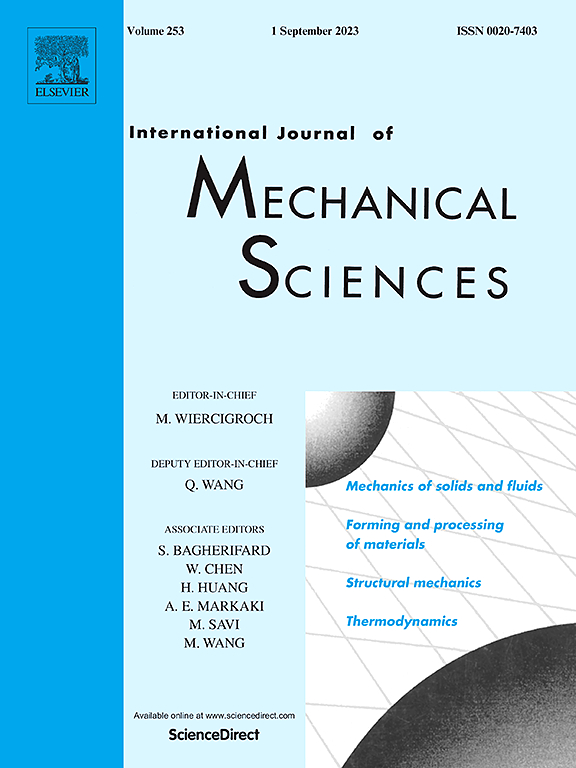Tailoring asymmetry for anisotropic friction in kirigami metamaterial skins with pop-up folding hinges
IF 7.1
1区 工程技术
Q1 ENGINEERING, MECHANICAL
International Journal of Mechanical Sciences
Pub Date : 2025-04-26
DOI:10.1016/j.ijmecsci.2025.110258
引用次数: 0
Abstract
Kirigami metamaterial sheets and tubes, owing to their capacity to undergo large elastic deformations while developing three-dimensional surface textures, have enormous potential as skins for soft robots. Here, we propose to use kirigami skins with folding hinges in this same context. These recently-introduced kirigami feature counter-rotating panels connected by pop-up folding hinges. So far, researchers have only explored auxetic and highly-symmetric versions of such patterns. Yet, some of these attributes have to be relaxed in order to explore their full potential as robotic skins. Thus, we parameterize these patterns and relax symmetry constraints, with the goal of using this same platform to obtain a wide range of shape-morphing behaviors. We derive kinematic formulas to explore the vast symmetry-enabled design space. We then use numerical simulations and experiments to validate the kinematic predictions and to explore the morphing mechanics of tubular skins. Finally, via experiments, we provide preliminary evidence of the anisotropic friction enabled by patterns with asymmetric pop-ups. We therefore demonstrate that it is possible to tailor parameters in kirigami with folding hinges to obtain skins that globally expand or contract due to axial elongation, and that present asymmetric pop-ups that yield anisotropic friction — the most desired attribute for one-way locomotion of soft robots.

具有弹出式折叠铰链的基里伽米超材料表皮中各向异性摩擦的剪裁不对称
Kirigami超材料片和管,由于它们在形成三维表面纹理时能够经历大的弹性变形,具有作为软机器人皮肤的巨大潜力。在这里,我们建议在相同的背景下使用带有折叠铰链的基里伽米皮肤。这些最近推出的kirigami的特点是通过弹出式折叠铰链连接的反向旋转面板。到目前为止,研究人员只探索了这种模式的辅助和高度对称版本。然而,为了充分发挥机器人皮肤的潜力,必须放松其中的一些属性。因此,我们将这些模式参数化并放宽对称约束,目标是使用相同的平台获得广泛的形状变形行为。我们推导了运动学公式来探索巨大的对称设计空间。然后,我们使用数值模拟和实验来验证运动学预测,并探索管状皮肤的变形力学。最后,通过实验,我们提供了具有不对称弹出框图案的各向异性摩擦的初步证据。因此,我们证明了在kirigami中使用折叠铰链定制参数是可能的,以获得由于轴向延伸而整体膨胀或收缩的皮肤,并且呈现不对称的弹出窗口,从而产生各向异性摩擦——这是软机器人单向运动最期望的属性。
本文章由计算机程序翻译,如有差异,请以英文原文为准。
求助全文
约1分钟内获得全文
求助全文
来源期刊

International Journal of Mechanical Sciences
工程技术-工程:机械
CiteScore
12.80
自引率
17.80%
发文量
769
审稿时长
19 days
期刊介绍:
The International Journal of Mechanical Sciences (IJMS) serves as a global platform for the publication and dissemination of original research that contributes to a deeper scientific understanding of the fundamental disciplines within mechanical, civil, and material engineering.
The primary focus of IJMS is to showcase innovative and ground-breaking work that utilizes analytical and computational modeling techniques, such as Finite Element Method (FEM), Boundary Element Method (BEM), and mesh-free methods, among others. These modeling methods are applied to diverse fields including rigid-body mechanics (e.g., dynamics, vibration, stability), structural mechanics, metal forming, advanced materials (e.g., metals, composites, cellular, smart) behavior and applications, impact mechanics, strain localization, and other nonlinear effects (e.g., large deflections, plasticity, fracture).
Additionally, IJMS covers the realms of fluid mechanics (both external and internal flows), tribology, thermodynamics, and materials processing. These subjects collectively form the core of the journal's content.
In summary, IJMS provides a prestigious platform for researchers to present their original contributions, shedding light on analytical and computational modeling methods in various areas of mechanical engineering, as well as exploring the behavior and application of advanced materials, fluid mechanics, thermodynamics, and materials processing.
 求助内容:
求助内容: 应助结果提醒方式:
应助结果提醒方式:


